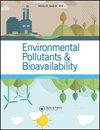尼日利亚东南部奥班地块和Mamfe mMbayment地下水微量和稀土元素的化学形态和络合模拟
Q3 Chemical Engineering
引用次数: 4
摘要
摘要对尼日利亚东南部奥班地块和Mamfe Mbayment地区水样微量元素和稀土元素数据进行了微量元素和稀土元素化学形态分析。稀土元素Pr与Nd、Pr与Lu、Sm与Nd、Sm与Pr、Tb与Nd、Tm与Tb、Yb与Nd之间的积矩相关性在r>0.7处呈显著相关。形态模拟结果表明,钻孔和泉水样品中游离金属离子种类占主导地位。主要的微量金属配合物是OH-配体。过饱和度(S= >1)钻孔微量元素矿物饱和度指数预测矿物种类多于平衡饱和度(S=0)。钻孔中稀土元素矿物过饱和度(s>1)预测矿物种类最少。欠饱和(S1)预测的矿物范围大于平衡(S=O),而S<1时预测的矿物范围最大。研究区内稀土元素在欠饱和条件下析出。本文章由计算机程序翻译,如有差异,请以英文原文为准。
Chemical speciation and complexation modeling of trace and rare earth elements in groundwater of Oban Massif and Mamfe mMbayment southeastern Nigeria
ABSTRACT Chemical speciation was carried out on trace and rare earth elements on trace and rare earth elements data on water samples in Oban Massif and Mamfe Mbayment southeastern Nigeria. Product moment correlation showed significant correlation at r>0.7 between REEs Pr and Nd, Pr and Lu, Sm and Nd, Sm and Pr, Tb and Nd, Tm and Tb, and Yb and Nd. Speciation modeling result showed that free metal ionic species dominated boreholes and spring water samples. The predominant trace metal complex is the OH- ligand. Trace elements mineral saturation indexes in boreholes at oversaturation (S>1) predicted more mineral species than equilibrium saturation (S=0). Rare earth elements mineral oversaturation (S>1) in boreholes predicted least mineral species. Undersaturation (S<1) predicted highest range of rare earth elements minerals. Springs and streams at S>1, predicted more mineral range than equilibrium (S=O) while mineral prediction at S<1 were the highest. Rare earth elements are precipitated at undersaturated condition in the study area.
求助全文
通过发布文献求助,成功后即可免费获取论文全文。
去求助
来源期刊
CiteScore
1.62
自引率
0.00%
发文量
0
审稿时长
1 months
期刊介绍:
Chemical Speciation & Bioavailability ( CS&B) is a scholarly, peer-reviewed forum for insights on the chemical aspects of occurrence, distribution, transport, transformation, transfer, fate, and effects of substances in the environment and biota, and their impacts on the uptake of the substances by living organisms. Substances of interests include both beneficial and toxic ones, especially nutrients, heavy metals, persistent organic pollutants, and emerging contaminants, such as engineered nanomaterials, as well as pharmaceuticals and personal-care products as pollutants. It is the aim of this Journal to develop an international community of experienced colleagues to promote the research, discussion, review, and spread of information on chemical speciation and bioavailability, which is a topic of interest to researchers in many disciplines, including environmental, chemical, biological, food, medical, toxicology, and health sciences.
Key themes in the scope of the Journal include, but are not limited to, the following “6Ms”:
Methods for speciation analysis and the evaluation of bioavailability, especially the development, validation, and application of novel methods and techniques.
Media that sustain the processes of release, distribution, transformation, and transfer of chemical speciation; of particular interest are emerging contaminants, such as engineered nanomaterials, pharmaceuticals, and personal-care products.
Mobility of substance species in environment and biota, either spatially or temporally.
Matters that influence the chemical speciation and bioavailability, mainly environmentally relevant conditions.
Mechanisms that govern the transport, transformation, transfer, and fate of chemical speciation in the environment, and the biouptake of substances.
Models for the simulation of chemical speciation and bioavailability, and for the prediction of toxicity.
Chemical Speciation & Bioavailability is a fully open access journal. This means all submitted articles will, if accepted, be available for anyone to read, anywhere, at any time. immediately on publication. There are no charges for submission to this journal.

 求助内容:
求助内容: 应助结果提醒方式:
应助结果提醒方式:


